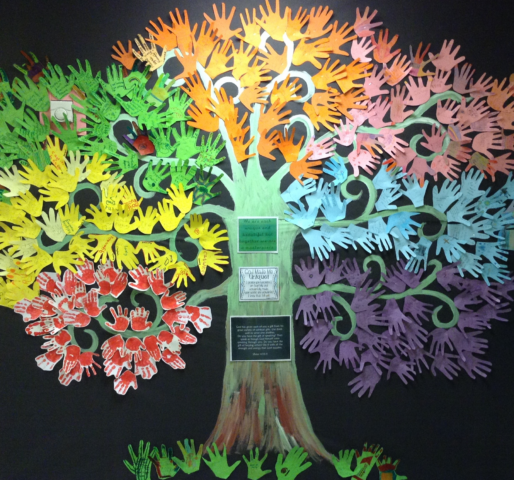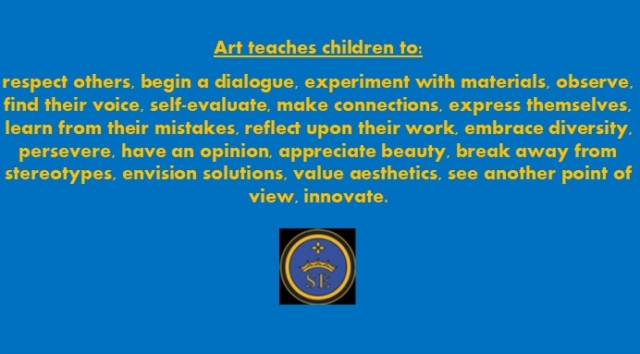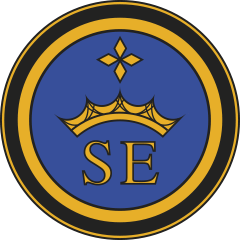
“It must not be forgotten that the basic law of children’s creativity is that its value lies not in its results, not in the product of creation, but in the process itself. It is not important what children create, but that they do create, that they exercise and implement their creative imagination.”
Lev Vygotsky
Art and Design Vision Statement
At St. Elizabeth’s we believe that art and design stimulate both creativity and imagination and as such form an important area of our pupil’s learning. Through the visual, tactile and sensory experiences provided in our art and design curriculum we wish to develop a special way for our pupils to understand and respond to the world around them.
We aim to engender in our pupils a love and appreciation of the arts by providing opportunities to:
- explore and evaluate artists
- communicate what they see, feel and think about art
- create art through the use of colour, texture, form, pattern as well as the use of different materials and processes
We aim to engage, inspire and challenge pupils, equipping them with the knowledge and skills to experiment, invent and create their own works of art, craft and design. (As referenced by the Education Endowment Foundation Projects – Arts Participation 5th September 2018). Furthermore, developing resilience and enabling their creativity to blossom to its full potential.

Curriculum Intent
The art and design curriculum promotes curiosity and a love and thirst for learning. It is ambitious and empowers our children to become independent and resilient – like all curriculum areas.
We want to equip them with not only the minimum statutory requirements of the art and design National Curriculum but to prepare them for the opportunities, responsibilities and experiences of later life. For example, at the beginning of the new academic year all pupils work on a collaborative piece of art for our entrance area which portrays our school mission statement and the Catholic Churches’ vision and mission for that year.
We want our children to use the vibrancy of our great city to learn from other cultures, respect diversity, co-operate with one another and appreciate what they have. We achieve this by providing a strong SMSC curriculum, with British Values and our core values placed at the heart of everything we do. This often feeds into the art and design curriculum. For example, Year 6 experience an interactive tour of the International Slavery Museum where pupils explore the collections of art and craft from West Africa and its close connection to the Slave Trade and the Port of Liverpool. The objects displayed in the exhibition have a global cultural influence and include masks, textiles and sculpted figures. This tour informs their own ability to generate ideas as well as record them using a sketch book in preparation for making art back in the classroom.
We enrich their time in our school with memorable, unforgettable experiences and provide opportunities which are normally out of reach – this piques their interests and passions. For example, historically pupils have taken part in a community art project in which they worked collaboratively with other schools to make a Remembrance Wreath from handmade poppies for display in Linacre Mission. We also make good links with our partner secondary schools; past examples of this have included pupils taking part in an art project at Savio Salesian College to make plastic sculptures to highlight the issue of plastic pollution, similarly other pupils developed print making skills at The Kings Leadership – Hawthornes during a Roald Dahl day. We firmly believe that it is not just about what happens in the classroom, it is about the added value we offer to really inspire our children.
Curriculum Implementation
In Autumn 2015, a complete audit of the art and design curriculum was conducted. On the basis of the findings of this audit, the art and design curriculum was carefully adapted and built using a framework produced by The National Society for Education in Art and Design (N.S.E.A.D.) The learning opportunities and assessment milestones for each year group have been crafted to ensure progression and repetition in terms of embedding key learning, knowledge and skills. The art curriculum has continued to be reviewed and updated annually by staff with support from the art lead where needed.
Staff have received specialist INSET training in relation to the teaching of art for example: May 2018 – ‘Talking about art and artists with pupils- questioning skills and knowledge’ February 2020 –‘Use of sketchbooks for Generating Ideas’ March 2022 – Printmaking techniques.
The way art and design is taught follows a specific and consistent structure. Initially, pupils take inspiration from artists throughout history to help generate ideas for their work. They explore and practise the practical skills and techniques involved in the topic and use their sketch books to record their observations and to review and revisit ideas before producing a final piece. This sequence is taken for every art and design topic. Disciplines are revisited in each key stage, at a progressively deeper level. For example, in Year 2 pupils create digital images using 2Simple to explore the work of Georgia O’Keefe, in Year 5 pupils use an on line tool ‘Tuxpi’ photo editor to manipulate digital images in relation to work completed on Andy Wahol while Year 6 use photography to collect detailed close up images linked to their study of Macro art and artists.
Art and design subject specific characteristics, which we expect the children to demonstrate, have been developed and shared with all stakeholders. These characteristics underpin all work in art and design and form a focal point for display areas and provide a common subject specific vocabulary for staff and pupils. These characteristics are:
- The ability to use visual language skilfully and convincingly (for example, line, shape, pattern, colour, texture, form) to express emotions, interpret observations, convey insights and accentuate their individuality.
- The ability to communicate fluently in visual and tactile form.
- The ability to draw confidently and adventurously from observation, memory and imagination.
- The ability to explore and invent marks, develop and deconstruct ideas and communicate perceptively and powerfully through purposeful drawing in 2D, 3D or digital media. An impressive knowledge and understanding of other artists, craft makers and designers.
- The ability to think and act like creative practitioners by using their knowledge and understanding to inform, inspire and interpret ideas, observations and feelings. Independence, initiative and originality which they can use to develop their creativity.
- The ability to select and use materials, processes and techniques skillfully and inventively to realise intentions and capitalise on the unexpected. The ability to reflect on, analyse and critically evaluate their own work and that of others.
- A passion for and a commitment to the subject.
We empower our staff to organise their own year group curricula with the support and guidance of the Art subject lead. Staff develop year group specific long-term curriculum maps which identify when the different art themes will be taught across the academic year. Art as a subject is taught discretely but staff make meaningful links across other subject areas. They link prior knowledge to new learning to deepen children’s learning. For example, in Year 6 the pupils explore Benin and West African art as inspiration for their sculpture topic: they learn about the slave trade and its abolition through History and read the ‘Kidnapped Prince’ in English. Additionally, a number of year groups complement the periods of History which they study by exploring the arts and crafts of a particular era and culture. Year 3 explore the art of the Stone Age and the art and crafts of the Celts. Year 4 learn about art and craft from the Anglo-Saxon period and Tudor portraiture while Year 5 study Ancient Egyptian and Ancient Greek art thus enhancing and deepening their knowledge and understanding of particular periods in history.
Our short-term plans are produced on a weekly and daily basis. We use these to set out the learning objectives for each lesson, identifying engaging activities and resources which will be used to achieve them.
Staff are encouraged to deliver one art theme per term which consists of one lesson per week for the duration of a half term. Thus 3 themes are taught in each year group per year. This helps to ensure sufficient time is allocated to art and design and that the subject matter can be revisited frequently. We believe that by crafting our curriculum this way, we improve the potential for our children to retain what they have been taught, to alter their long-term memory and thus improve the rates of progress they make.
Curriculum Impact
We use both formative and summative assessment information in art and design lessons. This is collected through direct observation, discussion with pupils and pupil self-assessment opportunities. Staff use this information to inform their short-term planning and short-term interventions. This helps us provide the best possible support for all of our pupils, including the more able. The assessment milestones for each progress objective have been carefully mapped out and further broken down for each year group (following guidance from N.S.E.A.D.) This means that skills in art and design are progressive and build year on year.
Our staff use art and design formative assessment grids to systematically assess what the children know as the topic progresses and inform their future planning. These formative assessment grids then inform summative assessment judgements for each topic. These assessment grids are then used to form a final end of year judgement that is in turn recorded on our Otrack tracking system.
Assessment information is collected termly and analysed as part of our monitoring cycle. This process provides an accurate and comprehensive understanding of the quality of education in art and design. A comprehensive monitoring cycle is developed at the beginning of each academic year. This identifies when monitoring is undertaken. The last art and design monitoring took place through a staff meeting reviewing planning, assessment and work sampling in June 2022. Monitoring in art and design can include: sketch book scrutinies, assessment moderation opportunities, learning walks, pupil/parent and/or staff voice.
All of this information is gathered and reviewed. It is used to inform further curriculum developments and provision is adapted accordingly.
